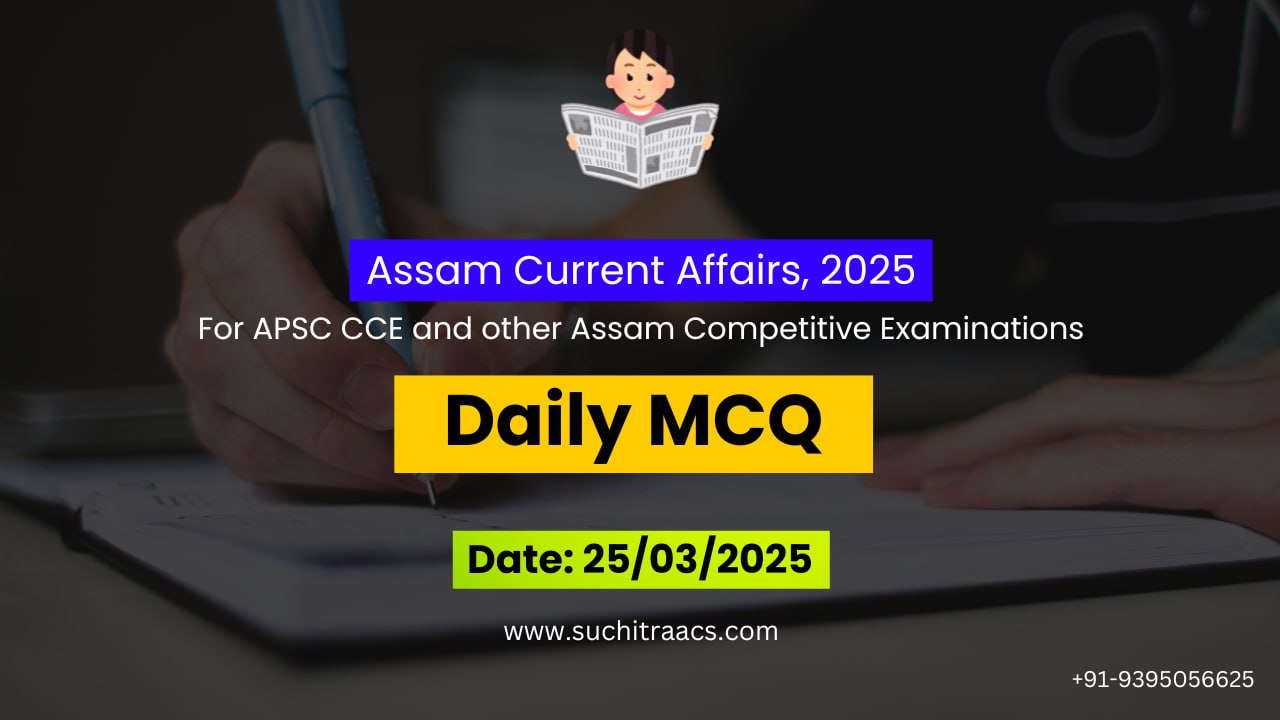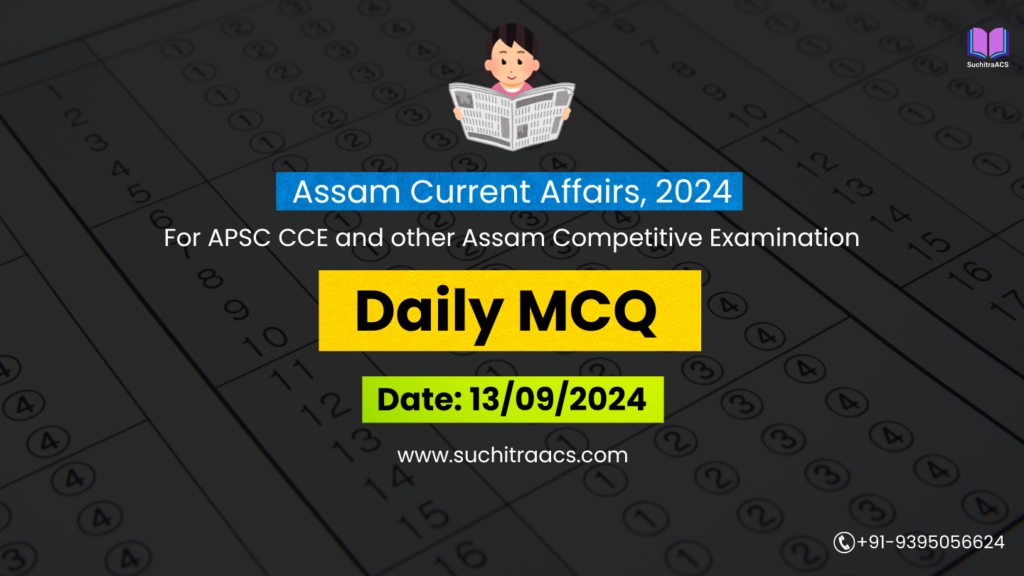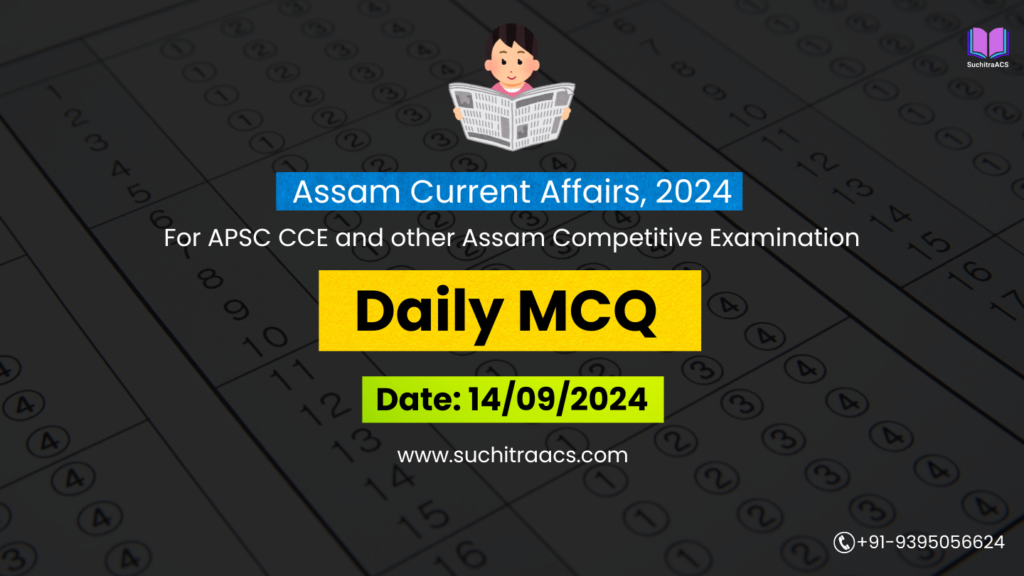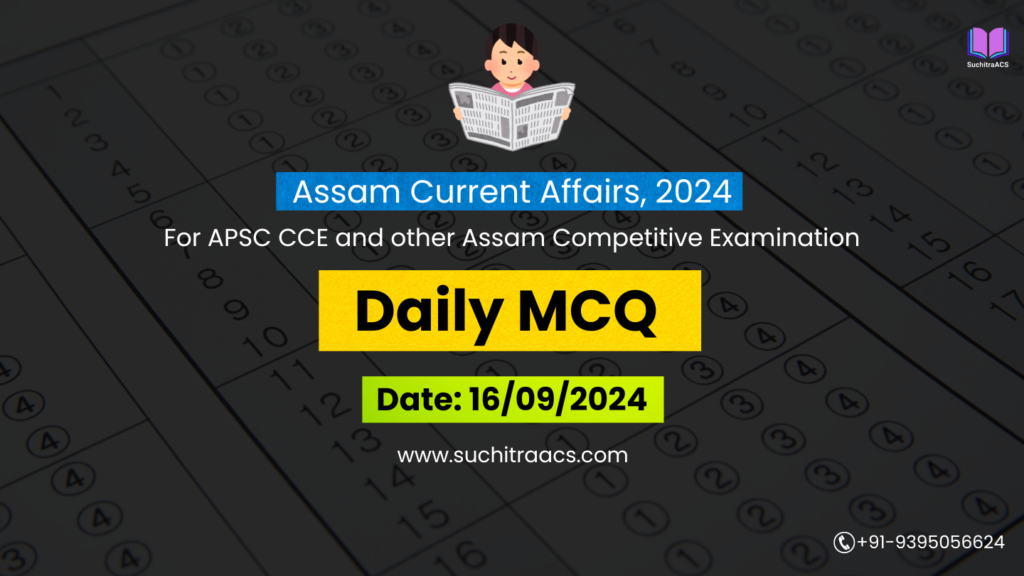APSC MCQs / APSC Prelims Practice Questions based on Assam Tribune (Daily) – 25/03/2025
For APSC CCE and other Assam Competitive examinations aspirants, practicing Daily MCQs is vital. This blog covers most important Prelims questions from the Assam Tribune today (25-03-2025). These issues are key for both APSC Prelims syllabus, offering insights into the important topics of current affairs.
APSC MCQs / APSC Prelims Practice Questions (Date: 25/03/2025)
Topic 1: Assam Most Vulnerable to Soil Erosion, Finds Study
Question 1
Which of the following factors contribute to high soil erosion in Assam?
- Heavy monsoon rainfall
- Riverbank erosion by the Brahmaputra River
- Deforestation and shifting cultivation
- High industrial pollution levels
Select the correct answer using the code below:
a) 1 and 2 only
b) 1, 2, and 3 only
c) 2, 3, and 4 only
d) 1, 2, 3, and 4
✅ Answer: b) 1, 2, and 3 only
Explanation:
- Assam experiences heavy monsoon rainfall, which accelerates runoff and soil erosion.
- Brahmaputra River’s strong currents cause severe bank erosion, displacing communities.
- Deforestation and shifting cultivation (Jhum) reduce soil stability, leading to higher erosion risks.
- Industrial pollution does not directly cause soil erosion but may affect soil quality, making statement 4 incorrect.
Question 2
Which of the following techniques can help control soil erosion in Assam?
- Contour plowing
- Vetiver grass plantation along riverbanks
- Unregulated sand and gravel mining
- Check dams and embankments
Select the correct answer using the code below:
a) 1 and 2 only
b) 1, 2, and 4 only
c) 2, 3, and 4 only
d) 1, 3, and 4 only
✅ Answer: b) 1, 2, and 4 only
Explanation:
- Contour plowing reduces surface runoff, minimizing soil loss.
- Vetiver grass plantation strengthens riverbanks, preventing erosion.
- Check dams and embankments regulate water flow, reducing erosion intensity.
- Unregulated sand and gravel mining worsens soil erosion, making statement 3 incorrect.
Topic 2: Assam to Implement AI-Based Crop Monitoring System for Farmers
Question 3
Which of the following technologies are used in AI-based crop monitoring systems?
- Satellite imagery and drones
- IoT-based soil sensors
- Blockchain technology
- Machine learning-based pest prediction models
Select the correct answer using the code below:
a) 1, 2, and 4 only
b) 1 and 3 only
c) 2, 3, and 4 only
d) 1, 2, 3, and 4
✅ Answer: a) 1, 2, and 4 only
Explanation:
- Satellite imagery and drones provide real-time monitoring of crops.
- IoT sensors measure soil health, moisture, and nutrient levels.
- Machine learning models predict pest outbreaks and recommend preventive actions.
- Blockchain is not a primary tool in crop monitoring but is used for agricultural supply chain management, making statement 3 incorrect.
Question 4
Which government schemes support technology-driven agriculture in India?
- Pradhan Mantri Fasal Bima Yojana (PMFBY)
- National e-Governance Plan in Agriculture (NeGPA)
- Soil Health Card Scheme
- Rashtriya Krishi Vikas Yojana (RKVY)
Select the correct answer using the code below:
a) 1 and 3 only
b) 1, 2, and 4 only
c) 1, 2, 3, and 4
d) 2 and 4 only
✅ Answer: c) 1, 2, 3, and 4
Explanation:
- PMFBY uses AI and satellite data for crop insurance assessments.
- NeGPA promotes digital agriculture and precision farming.
- Soil Health Card Scheme integrates AI for better soil fertility recommendations.
- RKVY provides funds for agri-tech adoption in states.
Topic 3: Assam to Develop Integrated River Basin Management Plan to Tackle Floods
Question 5
Which of the following are components of an Integrated River Basin Management Plan (IRBMP)?
- Multipurpose reservoirs for water storage
- AI-based flood early warning systems
- Expansion of riverbank sand mining
- Afforestation in catchment areas
Select the correct answer using the code below:
a) 1 and 2 only
b) 1, 2, and 4 only
c) 2, 3, and 4 only
d) 1, 2, 3, and 4
✅ Answer: b) 1, 2, and 4 only
Explanation:
- Multipurpose reservoirs store excess floodwater and ensure water availability.
- AI-based early warning systems help in flood forecasting.
- Afforestation in catchment areas reduces soil erosion and sedimentation.
- Sand mining increases erosion risks, making statement 3 incorrect.
Question 6
Which agencies are involved in flood management in Assam?
- Brahmaputra Board
- National Disaster Management Authority (NDMA)
- Central Water Commission (CWC)
- Geological Survey of India (GSI)
Select the correct answer using the code below:
a) 1 and 2 only
b) 1, 2, and 3 only
c) 2, 3, and 4 only
d) 1, 2, 3, and 4
✅ Answer: b) 1, 2, and 3 only
Explanation:
- Brahmaputra Board plans flood mitigation and river management in Assam.
- NDMA coordinates national-level disaster preparedness, including floods.
- CWC monitors water levels in major rivers and provides flood forecasts.
- GSI is mainly responsible for geological studies, not flood management, making statement 4 incorrect.
Topic 4: Assam to Introduce Electric Buses in Guwahati to Reduce Pollution
Question 7
Which of the following schemes support electric mobility in India?
- Faster Adoption and Manufacturing of Electric Vehicles (FAME)
- National Electric Mobility Mission Plan (NEMMP)
- Smart Cities Mission
- Pradhan Mantri Gram Sadak Yojana (PMGSY)
Select the correct answer using the code below:
a) 1 and 2 only
b) 1, 2, and 3 only
c) 2, 3, and 4 only
d) 1, 2, 3, and 4
✅ Answer: b) 1, 2, and 3 only
Explanation:
- FAME promotes EV adoption through subsidies.
- NEMMP sets targets for increasing EV production and infrastructure.
- Smart Cities Mission encourages green urban transport, including EVs.
- PMGSY focuses on rural road connectivity, not EV promotion, making statement 4 incorrect.
Question 8
Which of the following are advantages of electric buses?
- Zero tailpipe emissions
- Lower fuel costs compared to diesel buses
- Higher maintenance costs than conventional buses
- Reduced noise pollution
Select the correct answer using the code below:
a) 1 and 2 only
b) 1, 2, and 4 only
c) 2, 3, and 4 only
d) 1, 2, 3, and 4
✅ Answer: b) 1, 2, and 4 only
Explanation:
Electric buses reduce noise pollution, making them ideal for urban transport.
Electric buses produce no emissions, improving air quality.
EVs have lower fuel costs due to electricity being cheaper than diesel.
They have lower, not higher, maintenance costs due to fewer moving parts.
 APSC Prelims Crash Course, 2025
APSC Prelims Crash Course, 2025
at most affordable rate in Assam!

🔔 Join Our WhatsApp Study Group!
For exclusive access to premium quality content, including study materials, current affairs, MCQs, and model answers for APSC CCE and other Assam competitive exams.
Click here to join: SuchitraACS Study WhatsApp Group
📚 Want to know more about SuchitraACS’s most affordable courses?
Click here to know more: SuchitraACS Courses for APSC CCE and Assam Competitive Examinations




